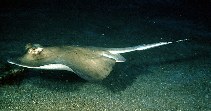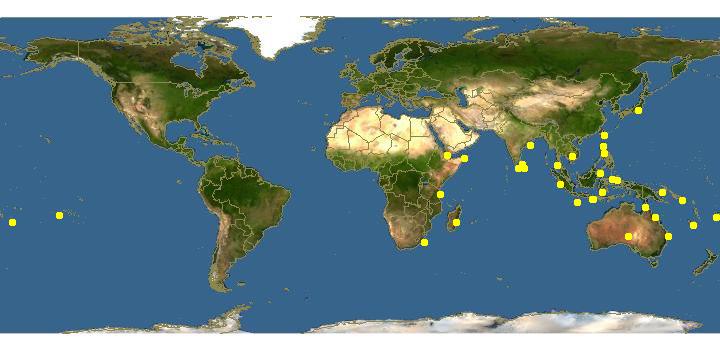http://www.fishbase.org/Summary/speciesSummary.php?genusname=Neotrygon&speciesname=kuhlii ---> http://192.134.151.83/Summary/speciesSummary.php?genusname=Neotrygon&speciesname=kuhlii
http://192.134.151.83/Summary/speciesSummary.php?genusname=Neotrygon&speciesname=kuhlii ---> https://fishbase.mnhn.fr/Summary/speciesSummary.php?genusname=Neotrygon&speciesname=kuhlii
https://fishbase.mnhn.fr/Summary/speciesSummary.php?genusname=Neotrygon&speciesname=kuhlii ---> https://fishbase.mnhn.fr/summary/Neotrygon-kuhlii.html
Neotrygon kuhlii, Blue-spotted stingray : fisheries, aquarium

You can
sponsor
this page
Common name (e.g. trout)
Genus + Species (e.g. Gadus morhua)
-

-
About this page
-
Languages
-
User feedbacks
-
Citation
-
Uploads
-
Related species
-


 Blue-spotted stingray
Add your observation in
Fish Watcher
Upload your
photos
and
videos
Blue-spotted stingray
Add your observation in
Fish Watcher
Upload your
photos
and
videos
Pictures
|
Videos |
Google image
 Neotrygon kuhlii
Neotrygon kuhlii
Picture by
Randall, J.E.
Elasmobranchii (sharks and rays) >
Myliobatiformes
(Stingrays) >
Dasyatidae
(Stingrays) > Neotrygoninae
Etymology: More on authors:
Müller
&
Henle
.
Issue
Formerly a widespread species, but forms a species complex with three other species. Information (data from references) collated undergoing modifications (in progress).
Environment: milieu / climate zone / depth range / distribution range
Ecology
Marine; reef-associated; depth range 0 - 170 m (Ref.
89055
), usually ? - 90 m (Ref.
9840
). Tropical; 33°N - 33°S, 28°E - 154°W
Southwest Pacific: Solomon Islands, but probably more widespread in Oceania (limits of its distribution need to be defined).
Forms a species complex with
Neotrygon australiae
(Australia, New Guinea and eastern Indonesia),
N. caeruleopunctata
(Indian Ocean), and
N. orientale
(North-West Pacific).
Length at first maturity / Size / Weight / Age
Maturity: L
m
27.6
, range 12 - 46.5 cm
Max length : 70.0 cm TL male/unsexed; (Ref.
5578
)
This medium-sized
Neotrygon
of the
kuhlii
-complex (reaching at least 30 cm DW) is distinguished by the following set of characters: disc is broader than long, its width ca. 1.2 times length; pectoral apices are narrowly rounded; snout rather fleshy, broadly angular, its angle ca. 107°, its length 1.7-2.1 times interorbital width; maximum width is relatively well back on disc, the length from snout tip to pectoral-fin insertion 1.8-1.9 times and disc width 2.5-2.6 times horizontal distance from snout tip to maximum disc width; preoral length is 2.4-2.8 times mouth width; internasal distance is 1.5-1.8 in prenasal length; interspiracular distance is 13-15% DW; nostril length is 2.8-4.1% DW; nasal curtain width is 8-8.3% DW; mouth small, its width 6.4-6.8% DW; horizontal distance from cloaca to caudal sting base ca. 55% of disc length; nuchal region with thornlets, none from tail in all sizes; no dermal denticles; 113 pectoral-fin radials (based on new specimen); 133 total vertebral centra (including synarcual), 39 trunk centra (including synarcual); presence of blue spots that are very small and sparse, largest spot on disc 0.3-0.5 times eye width; median belt with 0-6 (mean 3.0) blue spots, largest ~2.1% DW; pronounced mask-like marking, not covered with dark peppery spots; ventral surface of disc and pelvic fins with broad dark greyish submarginal bands; when fresh, ventral tail fold and adjacent tail bluish grey (Ref.
116741
).
A solitary species found on sandy bottoms near rocky or coral reefs (Ref.
12951
). Usually found in deeper water but moves onto the reef flat and into shallow lagoons at high tide (Ref.
12951
). Occasionally covers itself with sand, leaving only its eyes and tail visible (Ref.
37816
). Feeds on crabs and shrimps (Ref.
5578
). Ovoviviparous (Ref.
50449
). The venomous spine can inflict a painful wound (Ref.4690). Caught in very large quantities in the bottom trawl, trammel and fish trap fisheries. Utilized for its meat but of limited value due to its small size (Ref.
58048
). It is parasitised by the monogenean
Dendromonocotyle kuhlii
on the dorsal skin surface (Ref.
124051
).
Exhibit ovoviparity (aplacental viviparity), with embryos feeding initially on yolk, then receiving additional nourishment from the mother by indirect absorption of uterine fluid enriched with mucus, fat or protein through specialised structures (Ref.
50449
). Distinct pairing with embrace (Ref.
205
). Litters size at birth 16 cm (Ref.
37816
); Java form born at 11-16 cm WD, Bali form born at ~17 cm WD. Gives birth to litters of 1-2 pups; no reproductive synchronicity (Ref.
58048
).
Last, P.R., White, W.T. and B. Séret
, 2016. Taxonomic status of maskrays of the
Neotrygon kuhlii
species complex (Myliobatoidei: Dasyatidae) with the description of three new species from the Indo-West Pacific. Zootaxa 4083(4):533-561. (Ref.
116741
)
IUCN Red List Status (Ref.
130435
)
Data deficient (DD)
; Date assessed:
22 June 2017
CITES
Not Evaluated
Not Evaluated
Threat to humans
Venomous (Ref.
4690
)
Human uses
Fisheries: commercial; aquarium: commercial
FAO - Publication:
search
|
FishSource
|
Sea Around Us
More information
Countries
FAO areas
Ecosystems
Occurrences
Introductions
Stocks
Ecology
Diet
Food items
Food consumption
Ration
Common names
Synonyms
Metabolism
Predators
Ecotoxicology
Reproduction
Maturity
Spawning
Spawning aggregation
Fecundity
Eggs
Egg development
Age/Size
Growth
Length-weight
Length-length
Length-frequencies
Morphometrics
Morphology
Larvae
Larval dynamics
Recruitment
Abundance
BRUVS
References
Aquaculture
Aquaculture profile
Strains
Genetics
Electrophoreses
Heritability
Diseases
Processing
Nutrients
Mass conversion
Collaborators
Pictures
Stamps, Coins Misc.
Sounds
Ciguatera
Speed
Swim. type
Gill area
Otoliths
Brains
Vision
Tools
Bio-Quiz
|
E-book
|
Field guide
|
Identification keys
|
Length-frequency wizard
|
Life-history tool
|
Point map
|
Classification Tree
|
Catch-MSY
|
Special reports
Check for Aquarium maintenance
|
Check for Species Fact Sheets
|
Check for Aquaculture Fact Sheets
Download XML
Summary page
|
Point data
|
Common names
|
Photos
Internet sources
AFORO (otoliths) |
Aquatic Commons
|
BHL
|
Cloffa
|
BOLDSystems
|
Websites from users
|
Check FishWatcher
|
CISTI
|
Catalog of Fishes
:
genus
,
species
|
DiscoverLife
|
ECOTOX
| FAO - Publication:
search
|
Faunafri
| Fishipedia |
Fishtrace
| GenBank:
genome
,
nucleotide
|
GloBI
|
Google Books
|
Google Scholar
|
Google
|
IGFA World Record
|
MitoFish
|
National databases
|
Otolith Atlas of Taiwan Fishes
|
Public aquariums
|
PubMed
|
Reef Life Survey
| Socotra Atlas |
Tree of Life
| Wikipedia:
Go
,
Search
| World Records Freshwater Fishing |
Zoological Record
Estimates based on models
Preferred temperature (Ref.
123201
): 23.9 - 29, mean 27.8 °C (based on 2546 cells).
Phylogenetic diversity index (Ref.
82804
): PD
50
= 0.5039 [Uniqueness, from 0.5 = low to 2.0 = high].
Bayesian length-weight: a=0.01096 (0.00342 - 0.03513), b=3.11 (2.86 - 3.36), in cm total length, based on LWR estimates for this (Sub)family-body shape (Ref.
93245
).
Trophic level (Ref.
69278
): 3.3 ±0.3 se; based on diet studies.
Generation time: 8.5 ( na - na) years. Estimated as median ln(3)/K based on 2
growth studies.
Resilience (Ref.
120179
): Very Low, minimum population doubling time more than 14 years (Fec=1-3).
Fishing Vulnerability (Ref.
59153
): Moderate to high vulnerability (52 of 100).
Price category (Ref.
80766
):
Low
.
Nutrients (Ref.
124155
): Calcium = 14.2 [3.0, 58.7] mg/100g; Iron = 0.446 [0.109, 1.168] mg/100g; Protein = 22.2 [19.3, 25.3] %; Omega3 = 0.117 [0.035, 0.325] g/100g; Selenium = 32.2 [8.9, 82.3] μg/100g; VitaminA = 57.4 [22.8, 143.3] μg/100g; Zinc = 0.977 [0.477, 1.924] mg/100g (wet weight);
Back to Search
Random Species
Back to Top
Accessed through:
Not available
FishBase mirror site :
localhost
Page last modified by :
mrius-barile
- 20 July 2016
Fatal error
: Uncaught ArgumentCountError: Too few arguments to function checkEcotox(), 1 passed in /var/www/html/summary/speciessummary.php on line 2304 and exactly 3 expected in /var/www/html/includes/speciessummary.lib.php:2579 Stack trace: #0 /var/www/html/summary/speciessummary.php(2304): checkEcotox() #1 {main} thrown in
/var/www/html/includes/speciessummary.lib.php
on line
2579
|






